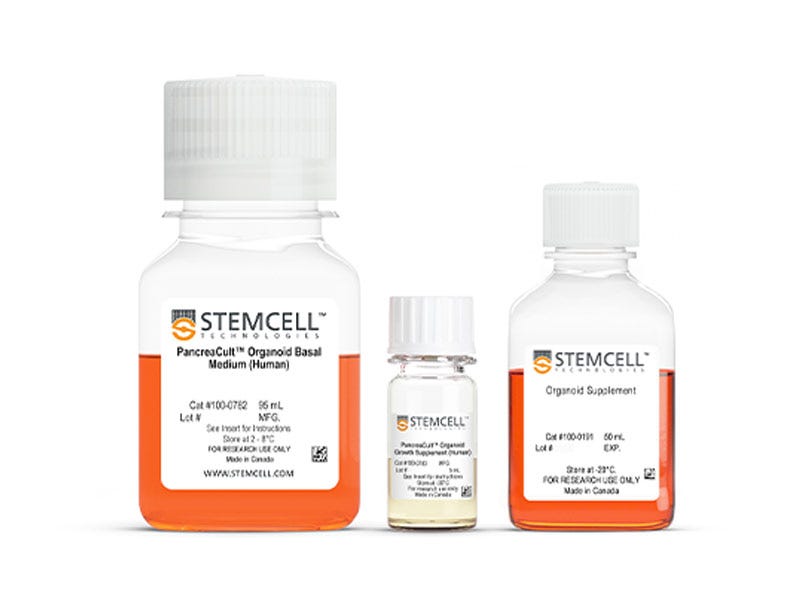用于胰腺类器官培养的 PancreaCult™ 培养基
为何选择 PancreaCult™ ?
- 可在一周内通过体外系统生成类器官。
- 无需损伤模型、手动挑选导管或细胞分选,提供标准化实验流程。
- 双组分体系设计,无血清且成分明确。
- 支持从导管碎片或单细胞培养类器官,并兼容基质胶包埋或悬浮培养模式。
胰腺类器官培养产品
品牌的历史
尽管近几十年来胰腺癌研究的重要性日益凸显,但直至近年,胰腺外分泌组织的离体培养仍面临重重困难。2013年, 梅里特塞尔·胡赫(Meritxell Huch)博士团队 首次实现将胰腺组织高效体外培养为类器官的技术突破。2014年,汉斯·克莱弗斯(Hans Clevers)教授创立的 Foundation Hubrecht Organoid Technology 与 STEMCELL 科技公司达成战略合作协议 ,共同推进类器官培养基的研发与商业化进程。2018年初,专为小鼠胰腺外分泌类器官设计的PancreaCult™类器官生长培养基正式问世,为科研工作者提供了稳定可靠的培养体系,显著提升了该领域研究的可操作性与成果产出效率。
Key Applications of Pancreatic Organoids
Adult-Tissue Derived Pancreatic Organoids
Broutier L, et al. (2016) Culture and establishment of self-renewing human and mouse adult liver and pancreas 3D organoids and their genetic manipulation. Nat Protoc. 11(9): 1724-43.
Hindley CJ, et al. (2016) Organoids from adult liver and pancreas: Stem cell biology and biomedical utility. Dev Biol. 420(2): 251-261.
Huch M, et al. (2013) Unlimited in vitro expansion of adult bi-potent pancreas progenitors through the Lgr5/R-spondin axis. EMBO J. 32(20): 2708-21.
hPSC-Derived Pancreatic Organoids
Hohwieler M, et al. (2016) Human pluripotent stem cell-derived acinar/ductal organoids generate human pancreas upon orthotopic transplantation and allow disease modelling. Gut. 66(3): 473-486.
Cancer Research
Avars M, et al. (2017) IL2RG, identified as overexpressed by RNA-seq profiling of pancreatic intraepithelial neoplasia, mediates pancreatic cancer growth. Oncotarget. 8(48): 83370-83383.
Ferreira RMM, et al. (2017) Duct- and acinar-derived pancreatic ductal adenocarcinomas show distinct tumor progression and marker expression. Cell Rep. 21(4): 966-978.
Chio II, et al. (2016) NRF2 Promotes Tumor Maintenance by Modulating mRNA Translation in Pancreatic Cancer. Cell. 166(4): 963-976.
Baker LA, et al. (2016) Modeling pancreatic cancer with organoids. Trends Cancer. 2(4): 176-190.
David CJ, et al. (2016) TGF-β tumor suppression through a lethal EMT. Cell. 164(5): 1015-30.
Boj SF, et al. (2015) Organoid models of human and mouse ductal pancreatic cancer. Cell. 160(1-2): 324-38.
Roe JS, et al. (2017) Enhancer reprogramming promotes pancreatic cancer metastasis. Cell. 170(5): 875-888.
Sinha S, et al. (2017) PanIN neuroendocrine cells promote tumorigenesis via neuronal cross-talk. Cancer Res. 77(8): 1868-1879.
Pancreatic Cell Biology
Park I, et al. (2017) HDAC2/3 binding and deacetylation of BubR1 initiates the spindle assembly checkpoint silencing. FEBS J. 284(23): 4035-4050.
Westphalen CB, et al. (2017) Dclk1 defines quiescent pancreatic progenitors that promote injury-induced regeneration and tumorigenesis. Cell Stem Cell. 18(4): 441-55.
Azzarelli R, et al. Multi-site neurogenin3 phosphorylation controls pancreatic endocrine differentiation. Dev Cell. 41(3): 274-286.


 EasySep™小鼠TIL(CD45)正选试剂盒
EasySep™小鼠TIL(CD45)正选试剂盒










 沪公网安备31010102008431号
沪公网安备31010102008431号